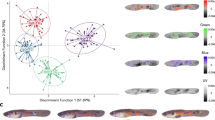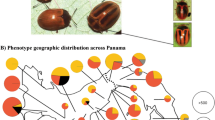VII. Summary
1. The woodlouse,Armadillidium vulgare, is polymorphic for body colours.
2. The rarer types of body colour may be due to either dominant or recessive factors. Some types are sex-limited to females.
3. Populations near Cambridge were scored for different colour types. About 12 per cent of the females were of the rarer types.
4. There was evidence in the case of the dominant factor for red body colour that heterozygotes were more viable than homozygotes.
5. Woodlice are eaten by birds, and this could be a cause maintaining the polymorphic structure of populations.
Similar content being viewed by others
References
Edney, E. B. (1953). The woodlice of Great Britain and Ireland—a concise systematic monograph.Proc. Linn. Soc., Lond.,164, 49–98.
Fisher, J. (1951 and 1955).Bird Recognition. Vol. II. Birds of Prey and Water-Fowl. Vol. III. Rails, Game-Birds and Larger Perching and Singing Birds. Penguin Books Ltd., Harmondsworth, Middlesex.
Haldane, J. B. S. (1955). On the biochemistry of heterosis, and the stabilization of polymorphism.Proc. Roy. Soc. B.,144, 217–20.
Howard, H. W. (1940). The genetics ofArmadillidium vulgare Latr. I. A general survey of the problems.J. Genet.,40, 83–108.
Howard, H. W. (1942). The genetics ofArmadillidium vulgare Latr. II. Studies on the inheritance of monogeny and amphogeny.J. Genet.,44, 143–59.
Howard, H. W. (1953). The genetics ofArmadillidium vulgare Latr. III. Dominant and recessive genes for red body colour.J. Genet.,51, 259–69.
Howard, H. W. (1958). The genetics ofArmadillidium vulgare Latr. IV. Lines breeding true for amphogeny and thelygeny.J. Genet.,56, 1–10.
Legrand, J. J. (1941). Cas d’intersexualité chez l’Isopode terrestreArmadillidium vulgare (Latreille).C. R. Acad. Sci., Paris,212, 808–10.
Vandel, A. (1939). Recherches sur la génétique d’Armadillidium vulgare (Latr.), dans ses rapports avec la monogénie.C. R. Acad. Sci., Paris,208, 1351–53.
Vandel, A. (1940). Les mutations chez les Isopodes terrestres.C. R. Acad. Sci., Paris,210, 231–33.
Vandel, A. (1945). Recherches sur la génétique et la sexualité des Isopodes terrestres. IX. Recherches de génétique sur quelques Oniscoïdes.Bull. biol.,79, 168–216.
Witherby, H. F., Jourdain, F. C. R., Ticehurst, N. F. andTucker, B. W. (1943).The Handbook of British Birds. 5 volumes Witherby, London
Author information
Authors and Affiliations
Rights and permissions
About this article
Cite this article
Howard, H.W. The genetics ofArmadillidium vulgare Latr. V. Factors for body colour. J Genet 58, 29–38 (1962). https://doi.org/10.1007/BF02986116
Received:
Issue Date:
DOI: https://doi.org/10.1007/BF02986116




